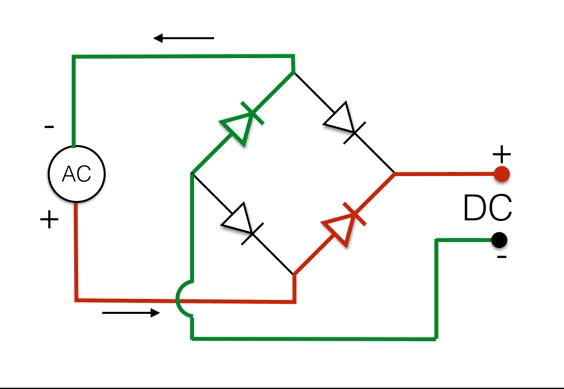Diodes
Table of Content
Diode Symbol and Generic Diode [1] |
|---|
General Considerations
Diodes have many characteristics that have to be accounted for. Some examples include the "turn on" voltage, referred to as forward voltage or voltage drop; maximum forward current, capacitance, leakage current, and reverse recovery time. Generally, diodes should never be exposed to large enough reverse voltages that can cause a reverse breakdown. The only exception is the zener diode [2].
How to Read Diode Datasheets
Depending on the application of the diode, datasheets will vary slightly.
How to Read a Diode Datasheet [3] |
|---|
|
Types of Diodes
| Full Wave Rectifier [7] | Data Line Protection [6] | Freewheel Diode [6] |
|---|---|---|
Schottky Clamped Transistors [12] |
|---|
Visualization of Voltage Regulation and Transient Suppressor [14] | Voltage Clipping Circuits [15] |
|---|---|
|
References
[1] "Diode: Definition, Symbols, and Types of Diode," Electrical 4 U, 8-Nov-2020. [Online]. Available: https://www.electrical4u.com/diode-working-principle-and-types-of-diode/. [Accessed: 19-Feb-2021]
[2] P. Horowitz and W. Hill, "1.6 Diodes and diode circuits," in The art of electronics, 3rd ed. Cambridge, UK: Cambridge University Press, 2015, pp. 31-39.
[3] Joel Gegner. "Introduction to Diodes - Part 2 - Reading a Datasheet," YouTube, 17-Sep-2014 [Video file]. Available: https://www.youtube.com/watch?v=rJuPcRVdqnI. [Accessed: 18-Mar-2021].
[4] "P-N junction semiconductor diode," Physics and Radio Electronics, 2015. [Online]. Available: https://www.physics-and-radio-electronics.com/electronic-devices-and-circuits/semiconductor-diodes/pnjunctionsemiconductordiode.html#:~:text=A%20p%2Dn%20junction%20diode%20is,in%20opposite%20or%20reverse%20direction.&text=The%20p%2Dn%20junction%2C%20which%20is,called%20as%20p%2Dn%20junction%20diode. [Accessed: 12-Mar-2021]
[5] "Power Diode and Rectifiers," Electronics Tutorials, n.d. [Online]. Available: https://www.electronics-tutorials.ws/diode/diode_5.html. [Accessed: 16-Mar-2021]
[6] "The Signal Diode," Electronics Tutorials, n.d. [Online]. Available: https://www.electronics-tutorials.ws/diode/diode_4.html. [Accessed: 16-Mar-2021]
[7] R. Allain. "How Do You Charge Your DC Phone With an AC Source," Wired, 24-Nov-2014. [Online]. Availble: https://www.wired.com/2014/11/charge-dc-phone-ac-source/. [Accessed: 17-Mar-2021]
[8] "100+ Electrical and Electronic Circuit Symbols," Electronics Hub, 23-Feb-2016. [Online]. Available: https://www.electronicshub.org/symbols/. [Accessed: 04-Mar-2021]
[9] "Laser Diodes: Laser diode operation 101: A users' guide," Laser Focus World, 10-May-2014. [Online]. Available: https://www.laserfocusworld.com/test-measurement/test-measurement/article/16550298/laser-diodes-laser-diode-operation-101-a-users-guide. [Accessed: 05-Mar-2021]
[10] "What is a Photodiode? Working, Characteristics, Applications," Available: https://www.electronicshub.org/photodiode-working-characteristics-applications/. [Accessed: 18-Mar-2021]
[11] "What is a Photodiode?" Wavelength Electronics, n.d. [Online]. Available: https://www.teamwavelength.com/photodiode-basics/. [Accessed: 18-Mar-2021]
[12] "The Schottky Diode," Electronics Tutorials, n.d. [Online]. Available: https://www.electronics-tutorials.ws/diode/schottky-diode.html. [Accessed: 18-Mar-2021]
[13] "Zener Diode Tutorial," Electronics Hub, 12-Sep-2015. [Online]. Available: https://www.electronicshub.org/zener-diode-tutorial/. [Accessed: 18-Mar-2021]
[14] Physics Video by Eugene Khutoryansky. "Zener Diodes in electric circuits - Voltage Regulators and Transient Suppressors," YouTube, 25-May-2019. [Online]. Available: https://youtu.be/V5nWu8EbMhI. [Accessed: 18-Mar-2021]
[15] "Diode Clipping Circuits," Electronics Tutorials, n.d. [Online]. Available: https://www.electronics-tutorials.ws/diode/diode-clipping-circuits.html. [Accessed: 01-Apr-2021]
Contributors:
| User | Last Update |
|---|---|
| Mayurakhi Khan | 1255 days ago |
Faculty Advisor: John Thistle, Kim Pope, Allyson Giannikouris, Michael Lenover (alumni)












